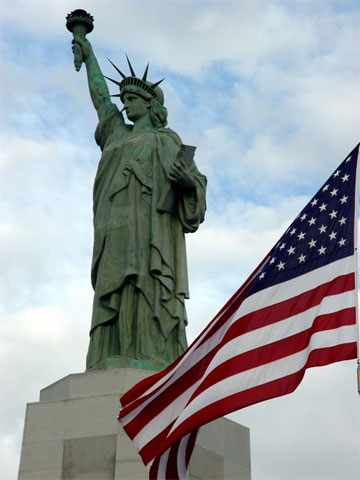 by Preston MacDougall April 03, 2006
For one thing, it completely ignores 15,000 "undocumented workers" crossing our border every day - from Canada. Currently, Canadians only require a birth certificate and/or a driver's license from their home province to gain entry into the US - documents that I am sure many Mexican migrant workers could also produce.
Like the "undocumented workers" crossing our other border, Canadians contribute enormously to our economy, and to our quality of life. If agents from the INS were to do a document sweep during the first intermission of a NHL hockey game in Nashville, I doubt that the skill and tempo would drop with the puck in the second period. That's why professional athletes have their own agents. However, if the INS agents were to do a document sweep of all the honky-tonks in Nashville, I wouldn't be surprised if their dragnet snared a few crooners from Calgary, or fiddlers from Fredericton. They may have entered the US legally, but without additional documents their gifted performances may be illegal. As the title of this commentary suggests, it is not primarily about the xenophobes among us, but the xenophiles. Two chemists in the U.K., Sir William Ramsay and Morris Travers, discovered the element xenon in 1898. It wasn't isolated from a mineral, as was the case for the majority of elements on the periodic table. It had been in the air all along, but only at levels of several parts per million. With his exceedingly careful analysis of liquefied air, Ramsay was the first to isolate all of the other so-called "noble gases" of the periodic table, except for radon. Radon is a radioactive gas that is fortunately not long-lived enough to dangerously accumulate in the atmosphere. Miners need to be aware of it, however. Xenon is the Greek word for stranger. For a long time it was thought that xenon was incapable of forming bonds with its fellow elements on the periodic table. Over the next half-century, many attempts were made - notably by the great American chemist Linus Pauling - but they all resulted in failure. Chemists were so convinced of the bonding incapacity of xenon and its fellow elements from the rightmost (18th) column of the periodic table, that wall-charts in chemistry lecture rooms labeled them the "INERT GASES". One such chart adds to the period décor of the physical chemistry lab at my university. It was made in 1968, when the building was new. While many students have entered that lab, and come out wiser about our molecular world, the wall-chart still displays its ignorance in bold capitals. You see, in 1962 a British chemist named Neil Bartlett, who is currently an emeritus professor of chemistry at Berkeley, but was a young faculty member at the University of British Columbia at the time, demonstrated that xenon easily contributed one of its electrons to platinum hexafluoride, forming a stable compound. News of this discovery crossed the 49th parallel and chemists at Argonne National Laboratory quickly demonstrated that xenon formed a family of compounds with the elements fluorine and oxygen. Brave Argonne chemists even prepared a fluoride of radon, which could only be partially characterized due to its intense radioactivity. By 1963, chemists at Berkeley had succeeded in preparing a compound of xenon's upstairs neighbor on the periodic table - krypton. Krypton difluoride is not radioactive, but requires just as much handling care as radon difluoride - if you want to keep your thumbs attached to your hands, that is. I don't recall chemists leading
any mass marches to the head office of Fisher Scientific in the
late '60s, but such companies soon saw the light anyway. From
the early '70s onward, the rightmost column of most periodic
wall-charts has the more edified heading NOBLE GASES. Ironically, the largest economic impact of xenon chemistry is at the nano-scale. In 1971, Russian scientists discovered a new kind of laser that emitted intense beams of ultraviolet light. They called it an excimer laser because the light originated from excited dimers (bonded pairs) of xenon atoms. Soon after, American researchers at the Naval Research Lab went deeper into the UV range with excimer lasers based on xenon's fleeting bonds to bromine. Photolithography technology is used to etch and sketch microscopic transistors and circuits on silicon computer chips. Argon fluoride excimer lasers, that emit deep UV light at 193 nanometers, are the industry standard. One question that members of
Congress should be asking themselves is "Where would we
be without xenophiles like Neil Bartlett, Emma Lazarus, or Lady
Liberty herself?" A golden revolving door might be
a very bright idea.
Publish A Letter on SitNews Read Letters/Opinions Submit A Letter to the Editor
|
||
